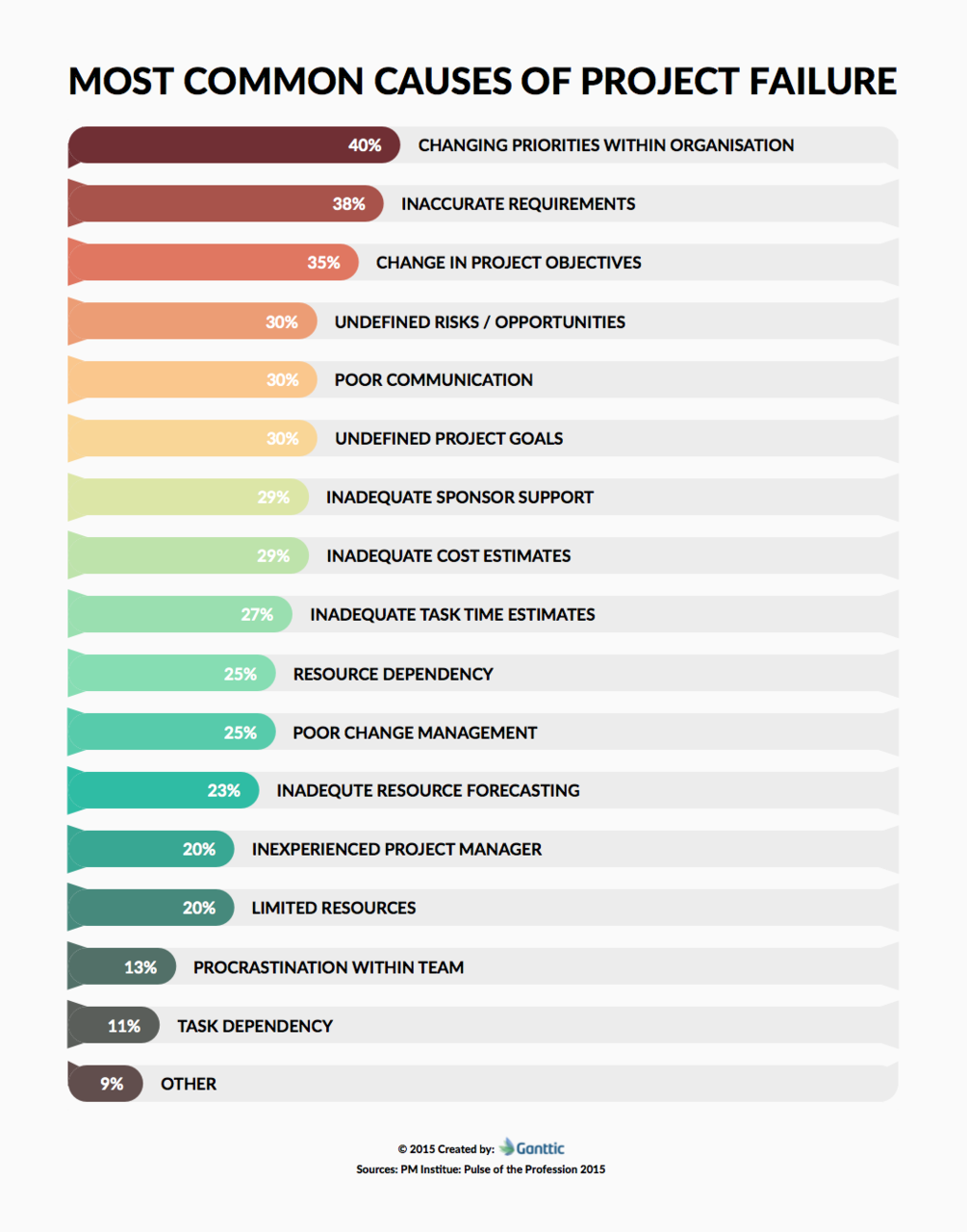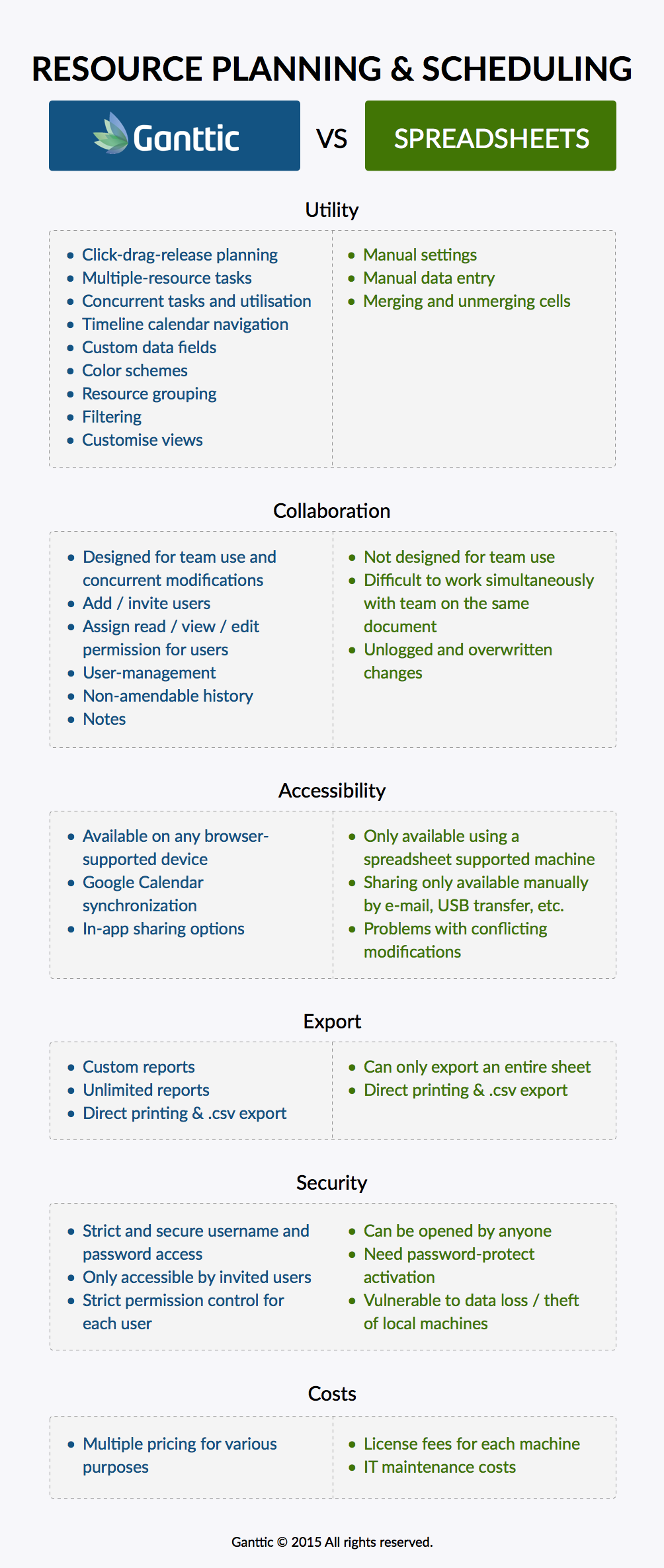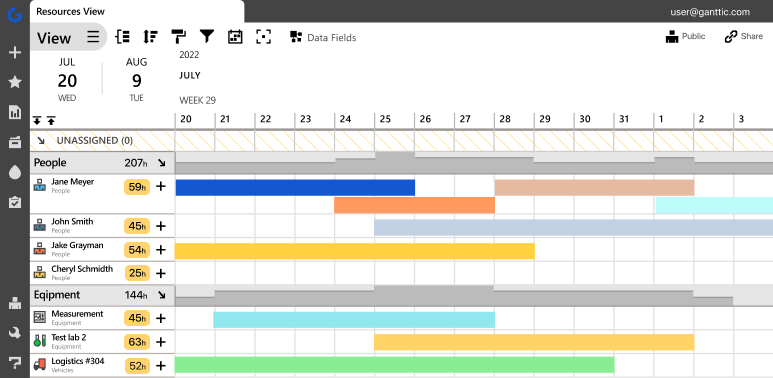It’s hard to cut ties with something you love. Even if you know it’s bad for you. That’s something we see all the time with project and resource managers and their continued reliance on spreadsheets. And while there’s a lot of risk of transitioning to another solution, letting your management processes linger in the stone-age just isn’t an option you should even be considering.
Outgrowing Excel is actually a good thing! As it means you’re doing something right and business is growing. Keep the momentum alive by considering just some of the ways that spreadsheets may actually be holding you back.
Why Do Projects Fail?
Research shows that there are 16 main common causes of project failure. The most common causes are changing priorities within organizations, inaccurate requirements and change in project objectives. Take a look at the infographic below.

While there are plenty of reasons for your projects to fail, it’s clear that poor planning plays a major role. Contributions to poor planning could be due to leadership, communication, teamwork and even software.
And it stands to reason, that if these common causes can be avoided, they shouldn’t be allowed to continue. It is important to change up the obsolete to a current solution if managers are serious about avoiding project failure at all cost. In resource planning, many have used spreadsheets to manage resources and plan projects, but is that the cheapest, fastest and easiest way to do it in this era? Or is it just because it’s what they know?
Why People Love Excel
We are a huge fan of spreadsheets. They have been a life-saver for many of us in the workforce as well as students and home care-takers around the globe. They were made for a wide array of purposes, useful for anything from budgeting to keeping scores.
With its powerful features that allows you to generate charts, do calculations, format cells, using PivotTables (aren’t we all so glad this came about!) and more – spreadsheets were godsend. But as start-ups and technology advancements started sprouting over the past decade, a portion of the problems that spreadsheets have solved for us are gradually being replaced by a variety of other products.
These new solutions are crafted specifically to address a particular need, without the generalization that you have to work your way around. Think of it as a fitting like a glove. Or the “kitten mantra”- where all cats enjoy sitting in vases and boxes, never mind how oddly shaped.
Resource Planning + Spreadsheets = Bad Combo
Take resource planning for example. While spreadsheets allow you to list out all your team names, their departments, the jobs that they are undertaking and more, it is not the cleverest way of planning. Especially in the ways that modern teams need it.
Without a transparent and flexible way to collaborate, it’s impossible to stay on top of things. Resource planning softwares are made to tackle all issues revolving collaboration, scheduling, communication and more.
The Top Limitations of Excel for Resource & Project Planning
In our opinion, there are six main limitations in Excel’s spreadsheets – and that resource management software is better equipped to handle:

1. Utility
When building a plan, you need to make sure that you can execute it. And that you have the right tools to help bring you plan to fruition. Using clunky software will not help in this regard. So choose something that will.
In Excel, not only are you wrestling with cells, but also struggling to format data types. Not to mention cutting and pasting your way around merged cells. So while this is an excellent example of the great things that Excel can achieve, also shows the frustration that many people feel about using it.
Precisely because it’s meant for so many purposes, the process can be much longer than necessary. And as such it might be time to cut ties with the bad habit that’s holding you back.
2. Collaboration
Excel was not created with collaboration in mind. And while online spreadsheets have overcome a lot of those unnecessary hurdles, the tool simply isn’t meant for resource planning involving multiple users. That’s because with spreadsheets there’s no resource management features built in. And even with a template in tow, you still run the risk of resource over-utilization, resource stealing, and double-booking across projects.
3. Accessibility
Have you ever tried viewing an Excel sheet on a mobile device? What about editing data on a tablet? Let’s face it, mini spreadsheets, cells, and touchscreens just don’t go together. And let’s not even get started on the nightmare of trying to file-share a spreadsheet.
The solution for instant accessibility on-the-go is something that actually fits into your pocket. A resource planning app that lets you check in on the agenda for the day and as well as make some quick fixes to the day’s plan.
4. Data Export
While Excel allows you to save your data in many file formats, you are not able to extract the data that you need without having to do it manually. Meaning if you just want a simple resource report, you’re looking at hours of analysis and compiling something yourself.
5. Security
When you are using spreadsheets, you are vulnerable to a whole list of possibilities of losing your data. On top of corrupted files and viruses, you are also looking at the potential loss of your devices, which may lead to unbacked-up files being lost as well.
Having your data on the cloud is more than just convenience, but it is also addressing a security issue. As seen in the screenshot, the very same green lock appearing in bank websites and government websites means that you have a secure connection. Having a secure connection also means that the site’s certificate is valid and its identity has been verified by a trusted third party. You can be sure that you don’t have to worry about data theft.
6. Costs
Do you have the funds to cover the cost of your plans? And is the software you’re using helping or hurting in this regard?
For businesses, Microsoft charges a sum per user per month regardless of usage. At Ganttic, we believe in a lighter version of management. So you only pay for what you use resource-wise, but the cheapest plan we offer is free.
Resource Planning Without Limits

Ganttic is a resource planning software that can replace and build upon all the features you love about Excel. Visual, flexible, and powerful – it’s software that was created for project and resource managers comfortable with spreadsheets, but who either outgrew their old systems or are in need of a more dedicated option.
With all the features to help teams and managers with resourcing demands and meeting project goals. To try Ganttic for free, sign up here for a trial.